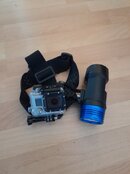If all those things on his head were handheld, there would be difficulties.
In the beginning you dive using your hands like a swimmer. Much like a baby or toddler crawls.
Then you learn how to dive properly, using your legs. Much as you learned to walk and run using your legs.
The fact is your legs are far more powerful than your arms and the fins you wear give you tremendous propulsion: anyone with fins can out swim an olympic swimmer (for a short distance at least).
When you've been diving for a bit with skilled people, not flappy leg divers, you'll find that you can swim forwards, backwards, turn around and generally hold yourself in position. No hands required.
When it comes to torches, they're far better off in your hand(s). Simply because they can be pointed at whatever you're looking at, using your eyes to look in that direction. Also you don't blind people. Most torches are narrow beams anyway, not least for signalling.
In Scotland you'll have variable conditions. Even if the visibility is good there's sometimes lots of tannin in the water which absorbs light. Loch Ness for example: very clear water but the tannin sucks the light.
When filming it's far more common to have your lighting to either side of the camera, separated by a foot or two. This gets less backscatter and is far more effective at getting a decent shot. Torches next to cameras is a very bad thing -- the lighting is horrible.
If you do need lighting on your head, as in caving and the like, you wear a helmet. These make excellent mountings for lights. Putting crap on your mask is just begging bother when it gets knocked off with kelp, the wreck, as you jump in, or should the strap fail.
Finally, you are presenting yourself as a very novice diver simply through all the things you've said. People on here are quite experienced divers and really do know more than you. You will learn and discover that head-mounted video is horrible underwater: you'll be amazed at how much your head moves.
Good luck with your diving.




